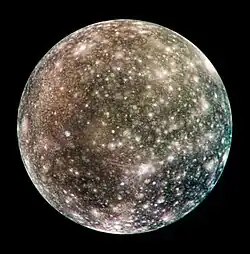Portal:Solar System/Selected article/23
Callisto is a moon of the planet Jupiter, discovered in 1610 by Galileo Galilei. It is the third-largest moon in the Solar System and the second largest in the Jovian system, after Ganymede. It is not a part of the orbital resonance that affects three inner Galilean satellites—Io, Europa and Ganymede—and thus does not experience appreciable tidal heating. Callisto rotates synchronously with its orbital period, so the same hemisphere is always turned toward Jupiter. It is composed of approximately equal amounts of rock and ices, with a mean density of about 1.83 g/cm3. Compounds detected spectroscopically on the surface include water ice, carbon dioxide, silicates, and organic compounds. Investigation by the Galileo spacecraft revealed that Callisto may have only partially differentiated interior covered by a thick icy crust and possibly a subsurface ocean of liquid water at depths greater than 100 km. Prominent surface features include multi-ring structures, variously shaped impact craters, and chains of craters and associated scarps, ridges and deposits. Callisto is surrounded by an extremely thin atmosphere composed of carbon dioxide and probably molecular oxygen, as well as by a rather dense ionosphere. (Full article...)
